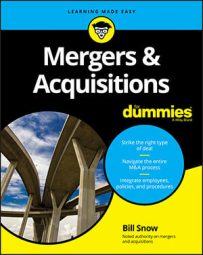Seller financing — why would a Seller do such a thing? Oh, that’s right: to help get am M&A deal done! A Seller willing to provide financing to a Buyer gains the benefit of being able to move on to the next phase of life — retirement, hobbies, charity work, or perhaps starting another business — while receiving consideration as the result of the sale.
Although cash is always king, a Seller who wants to get out of running the business may find that extending financing (in other words, accepting a promise from Buyer to pay Seller later) helps achieve that goal.
Seller financing also can be a way for a Buyer and Seller to conclude a transaction where Buyer is having difficulty obtaining outside capital. Instead of paying back a third-party lender (a bank, for example), Buyer pays back Seller. Seller is taking on the role of the lender.
The typical forms of Seller financing include
Seller note: Seller effectively loans money to the Buyer in order to help with the financing of the acquisition. Money doesn’t flow from the Seller to the Buyer and then back again. Instead, Seller agrees to allow Buyer to pay a certain portion of the transaction price at some later date.
Typically, these notes earn interest, either paid on a regular schedule (such as monthly, quarterly, or annually) or accrued and added to the loan, thus repaid when the loan is repaid.
Earn-out: Any kind of payment tied to some future measure of the acquired company’s performance is an earn-out. If Seller believes the company is worth more because she believes future earnings will reach a certain level, Buyer may agree to pay that higher price if the company achieves that certain goal. Earn-outs may be based on top line revenues, operation profit, EBITDA, gross margin, gross profit, sales increases, and so on.
If you agree to an earn-out, keep it as simple as possible. Overly complicating an earn-out is a sure recipe for a disagreement. For Sellers, the best measure of an earn-out may simply be sales. Post-closing, Seller won’t have any control over expenses or allocated expenses, so any target based on profitability will be tough to measure.
Delayed payments: Because time is effectively a part of consideration, delaying payments may be a way for Seller and Buyer to bridge a valuation gap. Simply allowing Buyer to make payments over time affords the Buyer with the ability to pay the price that the Seller wants to receive. Although as Seller you’d prefer $10 today, perhaps you’d be inclined to take $1 per week for the next 15 weeks.
Consulting agreement: An effective way to increase the deal value to Seller is to offer her a consulting agreement that pays her money over some period of time.
Any or all of these plans may be good options for a highly motivated Seller who trusts Buyer to hold up his end of the bargain.
As a Seller, accepting any kind of contingent payment involves an element of risk because you can’t be as sure you’ll be paid in full as you can when the cash is in your hand at closing. To mitigate some of that risk, demand some sort of premium for accepting it by making the contingent price higher.
Simply put, pay me $10 million today, or $5 million today plus another $10 million in three years.

